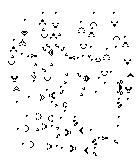Parabolic sawtooth
Parabolic sawtooth is a diagonal sawtooth that was discovered by Dean Hickerson on June 26, 1991. It is of special note because unlike most other sawtooths, its graph of population versus generation number is a sawtooth graph with parabolic (as opposed to linear) envelope and its population returns to 1208 in amounts of time that are quadratically spaced (as opposed to exponentially spaced, like most sawtooths). It can be reduced by using the Simkin glider gun instead of the Gosper glider gun-based p120 guns.
| Parabolic sawtooth | |||||||||
| |||||||||
| View static image | |||||||||
| Pattern type | Sawtooth | ||||||||
|---|---|---|---|---|---|---|---|---|---|
| Number of cells | 889 | ||||||||
| Bounding box | 126×114 | ||||||||
| Expansion factor | n/a | ||||||||
| Discovered by | Dean Hickerson | ||||||||
| Year of discovery | 1991 | ||||||||
| |||||||||
| |||||||||
The pattern works by repeating the following operation for each n ≥ 0:
- A 4-glider salvo is sent southeast toward a block A, arriving in generation 20n2 + 144n + a[n mod 3], where a[0]=a[2]=131 and a[1]=91.
- Block A is pushed 1 unit southeast and another block, B, is created upstream from block A. Every 108 generations, 2 gliders hit B and pull it 3 units northwest. Eventually block B gets deleted by a glider, at generation 20n2 + 180 n + b[n mod 3], where b[0]=193, b[1]=223, and b[2]=227.
- Another 4-glider salvo is sent toward block A.
The population is minimal around the time block B is deleted. The minimum repeating population that appears is 1208 in generations 180n2 + 540n + 210 and 180n2 + 660n + 450. The population is maximal around the time block B is created: there are about n/30 2-glider salvos on their way toward block B around generation t = 20n2 + 144n, so the population is about n/3 ~ sqrt(t/180) at that time.
Videos
See also
External links
- Parabolic sawtooth at the Life Pattern Catalog
